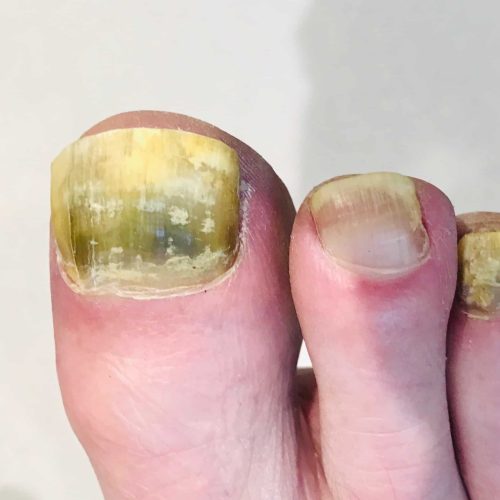Fungal Nail Infections
Fungal Nail Infections:
Causes, Treatment, and Prevention
Fungal nail infections, also known as onychomycosis, are common infections that affect the toenails and, less frequently, the fingernails. They occur when fungi invade the nail bed, leading to discoloration, thickening, and brittleness. While not typically dangerous, fungal nail infections can cause discomfort and may be difficult to treat. If left untreated, the infection can spread and cause further nail damage.
Causes and Symptoms
Fungal nail infections are caused by various types of fungi, primarily dermatophytes, which also cause athlete’s foot and ringworm. Other fungi, such as yeasts (Candida) and moulds, can also lead to nail infections. The fungi thrive in warm, moist environments and enter the nail through small cracks, cuts, or separation between the nail and nail bed.
Several risk factors increase the likelihood of developing a fungal nail infection, including:
- Poor foot hygiene and excessive sweating
- Walking barefoot in damp communal areas, such as gyms, swimming pools, and locker rooms
- Wearing tight or non-breathable shoes, which create a moist environment
- Having a history of athlete’s foot, as the infection can spread from the skin to the nails
- Weakened immune system, diabetes, or circulation problems, which make infections harder to fight off
Symptoms of Fungal Nail Infections
Fungal nail infections develop gradually and can affect part or all of the nail. Common symptoms include:
- Yellow, white, or brown discoloration of the nail
- Thickened or brittle nails that may crumble at the edges
- Distorted nail shape or separation from the nail bed
- A foul odour in more severe cases
- Pain or discomfort, particularly when wearing shoes
Fungal nail infections can affect one or multiple nails and may worsen over time if left untreated.
Treatment Options
Fungal nail infections can be challenging to treat because the fungi live underneath the nail. Treatment can take several months, and the nail may not return to normal until new, healthy nail growth occurs.
1. Over-the-Counter and Topical Treatments
- Antifungal nail lacquers, such as ciclopirox and amorolfine, can be applied directly to the affected nail.
- Antifungal creams containing terbinafine or clotrimazole may help, but they work best in mild cases.
- Nail softeners, such as urea-based creams, can help remove infected parts of the nail.
2. Prescription Oral Medications
- Terbinafine (Lamisil) and itraconazole (Sporanox) are commonly prescribed antifungal pills that treat nail infections more effectively than topical treatments.
- These medications typically require 6 to 12 weeks of treatment, but visible nail improvement may take several months.
- Potential side effects include liver damage or gastrointestinal issues, so they may not be suitable for everyone.
3. Laser Therapy and Surgical Removal
- Laser treatment can help destroy the fungus in the nail bed, but it is expensive and not always effective.
- In severe cases, surgical nail removal may be recommended to allow new, healthy nail growth.
4. Home Remedies and Natural Treatments (NOT RECOMMENDED due to lack of clinical evidence on efficiency to treat infection)
- Tea tree oil, known for its antifungal properties, may help improve mild infections, though this lacks any clinical evidence.
- Vinegar soaks and baking soda paste are sometimes used as home remedies to inhibit fungal growth, though they lack any clinical evidence to effectively treat fungal nail infections.
- Vicks Vaporub has been, in the past and unfortunately still is, recommended by various professionals to improve mild infections. Again, there is a lack of any clinical evidence on the efficacy of this as a treatment.
How to Prevent Fungal Nail Infections
Since fungal nail infections are difficult to treat, prevention is crucial. The following strategies can help reduce the risk of infection:
1. Maintain Good Foot and Nail Hygiene
- Keep nails trimmed and clean, cutting them straight across to prevent breakage.
- Wash feet regularly and dry them thoroughly, especially between the toes.
2. Wear Proper Footwear
- Choose breathable shoes made of leather or mesh to prevent moisture build-up.
- Avoid tight-fitting shoes that put pressure on the toenails.
- Wear moisture-wicking socks and change them if they become damp.
3. Use Antifungal Products
- Apply antifungal powders or sprays to feet and shoes to prevent fungal growth.
- If prone to athlete’s foot, treat it promptly to prevent it from spreading to the nails.
4. Avoid Nail Trauma and Contaminated Tools
- Do not share nail clippers, files, or shoes with others.
- If getting a pedicure, ensure that the salon sterilises tools properly.
Conclusion
Fungal nail infections are stubborn and persistent but can be treated with antifungal medications, proper foot care, and, in severe cases, medical intervention. Prevention is the best strategy, as avoiding excessive moisture, practicing good hygiene, and protecting feet in public areas can significantly reduce the risk of infection. If a fungal nail infection does not improve with home treatments or worsens over time, consulting a foot health practitioner is recommended for stronger treatments and personalised advice.

